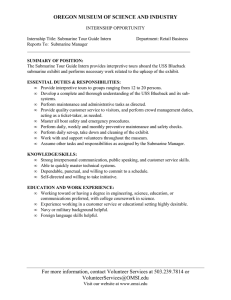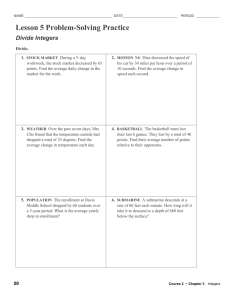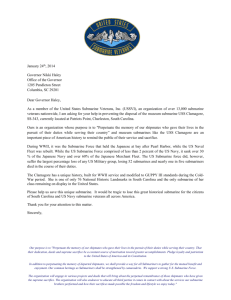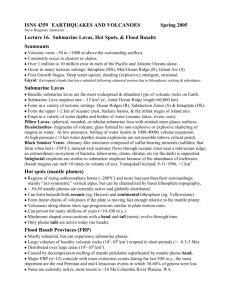Chapter 5. Conclusions
advertisement
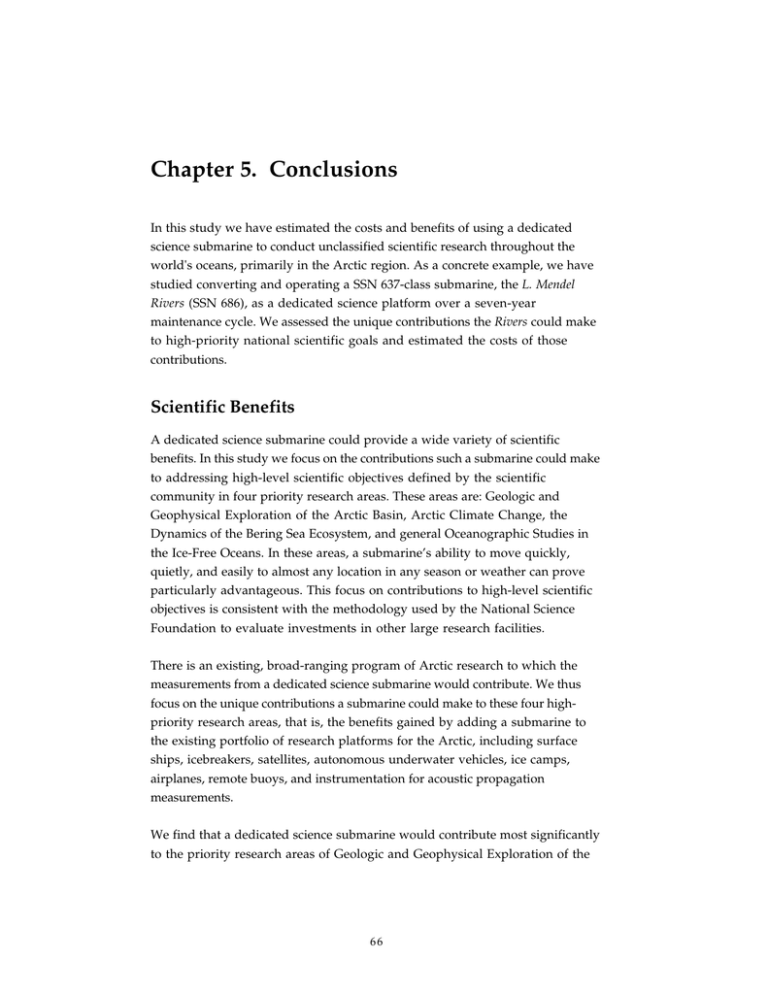
Chapter 5. Conclusions In this study we have estimated the costs and benefits of using a dedicated science submarine to conduct unclassified scientific research throughout the world's oceans, primarily in the Arctic region. As a concrete example, we have studied converting and operating a SSN 637-class submarine, the L. Mendel Rivers (SSN 686), as a dedicated science platform over a seven-year maintenance cycle. We assessed the unique contributions the Rivers could make to high-priority national scientific goals and estimated the costs of those contributions. Scientific Benefits A dedicated science submarine could provide a wide variety of scientific benefits. In this study we focus on the contributions such a submarine could make to addressing high-level scientific objectives defined by the scientific community in four priority research areas. These areas are: Geologic and Geophysical Exploration of the Arctic Basin, Arctic Climate Change, the Dynamics of the Bering Sea Ecosystem, and general Oceanographic Studies in the Ice-Free Oceans. In these areas, a submarine’s ability to move quickly, quietly, and easily to almost any location in any season or weather can prove particularly advantageous. This focus on contributions to high-level scientific objectives is consistent with the methodology used by the National Science Foundation to evaluate investments in other large research facilities. There is an existing, broad-ranging program of Arctic research to which the measurements from a dedicated science submarine would contribute. We thus focus on the unique contributions a submarine could make to these four highpriority research areas, that is, the benefits gained by adding a submarine to the existing portfolio of research platforms for the Arctic, including surface ships, icebreakers, satellites, autonomous underwater vehicles, ice camps, airplanes, remote buoys, and instrumentation for acoustic propagation measurements. We find that a dedicated science submarine would contribute most significantly to the priority research areas of Geologic and Geophysical Exploration of the 66 Arctic Basin and Arctic Climate Change. Central to these contributions is the submarine’s ability to collect survey data in ice-covered seas. A submarine is unmatched in its capability to collect large amounts of bathymetric or hydrographic data over the Arctic Basin, especially in the winter. A submarine also has unique capabilities to collect controlled seismic refraction and reflection surveys. Such data directly support the scientific objective of filling long-standing knowledge gaps regarding the Arctic Ocean basin. A dedicated science submarine could also make unique contributions to understanding the variability of the Arctic climate system and its relation to global climate change. For climate change research, the most important feature of the submarine is the capability to collect data over broad areas of the Arctic Basin at all times of year. Of particular importance are hydrographic measurements in the upper ocean (temperature/salinity profiles), detailed mapping of ice draft and structure, and high-resolution bathymetric surveys. To a lesser extent, the science submarine could also uniquely contribute to the priority research areas of Dynamics of the Bering Sea Ecosystem, and general Oceanographic Studies in the Ice-Free Oceans. In the Bering Sea the submarine has a unique capability to make hydrographic and ice-draft measurements under the ice and to monitor biological features, such as water sampling from specific oceanographic features and mapping fish and zooplankton populations. However, the extent of these benefits is limited by water in much of the Bering Sea that is insufficiently deep for safe submarine operations (40 percent of the Bering Sea is less than 100 m deep). In the ice-free oceans, the submarine has fewer unique capabilities relative to surface ships, satellites, and drifting buoys. Without the limitations of an ice cover, ships have greater navigational capabilities, satellites can image a range of ocean properties over vast areas, and buoys can drift great distances. Under these circumstances, the submarine’s primary strength centers on data gathering in remote regions, rough seas, and bad weather. Our analysis focuses on the benefits of a dedicated science submarine in relation to the proven, current capabilities of other research platforms. We note, however, that the technology associated with autonomous underwater vehicles is improving rapidly and could plausibly lead to platforms that equal or surpass many of the submarine’s unique measurement capabilities over the course of roughly a decade. 67 Costs The total cost of operating and maintaining the L. Mendel Rivers as a dedicated science submarine could range from roughly $200 million to $300 million over an expected seven years of operation. Approximately $95 million to $125 million would be required for depot overhaul and science conversion, $20 million to $37 for depot maintenance, $38 million to $53 million for operations including the cost of a Navy crew and consumables, and approximately $60 million for science support. The wide variations in potential costs are due in large part to different assumptions about whether the submarine could be overhauled and maintained at public or private shipyards, whether overhead costs would be shared between the Navy and NSF, and whether the costs of Navy crew members would be allocated to the dedicated science submarine when it was not at sea. These issues would likely be resolved and the cost made clearer if and when the government begins serious planning for a dedicated science submarine. The average annual cost of the submarine would range from $30 million to $40 million per year. By comparison, current NSF funding for Arctic research, logistics, and facilities support totaled approximately $70 million in FY 2000. The cost of the submarine is unevenly distributed over time. The initial overhaul and science conversion of the existing vessel account for more than a third of the total lifetime costs of the science submarine. Thus in any scenario, the majority of spending would occur in the first years of the program, and hence there is little flexibility to reduce costs by focusing the dedicated science submarine on a few high-priority missions. Assessment A dedicated science submarine could make unique and important contributions to the priority research areas of Geologic and Geophysical Exploration of the Arctic Basin and Arctic Climate Change. It could make unique, important, but relatively lesser contributions to the priority research areas of Bering Sea Ecosystem, and general Oceanographic Studies in the Ice-Free Oceans. Maintaining and operating a science submarine could cost $200 million to $300 million over seven years of operations. Many uncertainties remain over the extent of these benefits and costs. For instance, the submarine could have nonscientific benefits not considered in this study; or technological advances could produce autonomous underwater vehicles that in a decade or more could obtain 68 some of the measurements currently available only from a dedicated science submarine. Nonetheless, this report lays a foundation for decisionmaking on the deployment of such a research platform. Specifically we identify the priority research areas that would benefit most from the unique capabilities of a dedicated science submarine. Policymakers can assess the importance of these benefits in light of the costs we have identified. 69
